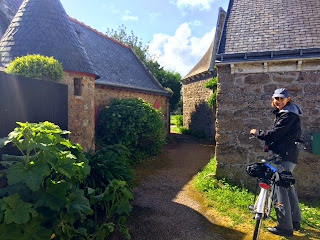Fishing is a primary occupation, from lone fishing boats to the mass production of oyster farms. Cod, shrimp, lobster, oysters, scallops are usually on the dinner menu.
Tourism runs a close second, especially from late spring to early fall, drawing thousands of French, a scattering of Germans and British, and the occasional American. Hiking trails are abundant along the coasts and across the headlands; bike rentals, too.
In spring, when we visited Brittany, crowds were thinner than in summer (though still shoulder-to-shoulder at St. Malo and Mont St. Michel) and temperatures much cooler, Along the coast, the wind could blow you over!
The best part about spring: wildflowers bloomed along every pathway and in every crack in the rocks.
Despite the astounding natural beauty of the surroundings, the rocky shores combined with extreme weather have accounted for thousands of shipwrecks and tragedies at sea.
Homes of pink granite blocks are built to withstand centuries of violent winds and storms--and many of them date from the 17th to 19th centuries. (Later retrofitted with water and electricity, of course.)
Equally important was the right to worship in the chapels and cathedrals protected by those fortifications; and the compulsion to hide behind those same walls when other religions came knocking.
The French love to hide behind their walls; or, if rock is not readily available, tall (just above eye level) yet attractive hedges. They surround almost every house, estate, field, walkway, lane.
Extreme tides, second only to those of Canada's east coast, require innovative engineering to keep maritime systems operating--supports bolted to the sides of boats to keep them upright during low tide, and long docks extending way out into deep water.
The towns close up tight early in the evening--quiet and deserted. Act fast to get into a restaurant (reservations help too; they are often full). Oysters and other seafood are on every menu--Pope enjoyed quite a few huitres. I also relied largely on fish, though I occasionally scored a salad or vegetables. At the many creperies, I enjoyed mushrooms and cream or egg and cheese wrapped in galettes (buckwheat savory crepes), and--on a delicious final note--chocolate, chestnut, or caramel dessert crepes.

































See any fossils on those rocky walks?
ReplyDelete